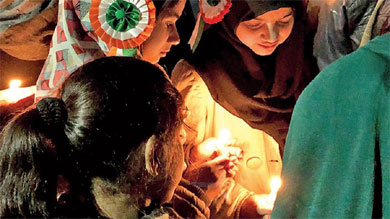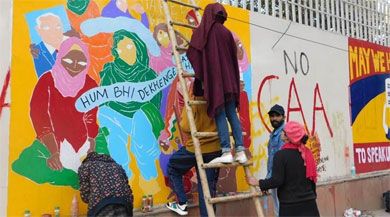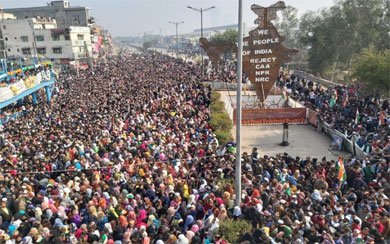
By S. Arshad, New Age Islam
08 February 2020
The death of a four month old baby Pari in Shaheen Bagh Delhi and an aged woman Sameeda Khatun in Kolkata during the protests against NCR regime has underlined the sincerity and intensity of participation of women in the protests and their social and political awareness and insight. It is also important to note that instead of demoralizing them and breaking their morale, the deaths have only strengthened their resolve to fight. During the last few days, several attempts have been made by goons to frighten them and with ‘suicide attacks’ by the terror outfit ‘Lashkar-e-Media’ but the women of Shaheen Bagh have firmly stood their ground.

Shaheen Bagh Protest
-----
It has been observed that during the last ten years, almost all the revolutionary movements in Asia have been led and actively participated by women and their participation has led to the success of the movements. The revolution and political changes in the Middle East and African countries during the Arab Spring in 2011 were brought about mainly by women. It was the women who had launched a protest movement against the dictatorship of Hosni Mobarak in Egypt on 25 January 2011 and after only 18 days, Hosni Mobarak had to step down and hand over the reins of the government to the Army. It is not that Mobarak did not try to crush the movement. He got army fighter planes to fly over the protesters to frighten them and also sent mercenaries to disperse the protesters but they had to beat a retreat before the strength of the protests. Finally, Hosni Mobarak had to resign. Thus, women played a vital role in the ushering of democracy in Egypt. During the protests young and old women and children on their mothers’ laps also participated which added to the strength of the protesters.

Shaheen Bagh Protest
-----
In Bangladesh, the Shahbagh Movement has also gone down in history. When, on 4 February 2013, the International War Crimes Tribunal sentenced Abdul Qadir Molla, an Al Badr militia member, to life imprisonment for his involvement in rape of an eleven year old girl and the massacre of 344 people during the Bangladesh war of liberation, majority of the people of the country were not satisfied with the ‘lenient’ punishment to the person whom they called a butcher. They started criticizing the punishment and demanded death sentence for him on Facebook and twitter. A young girl student, Lucky Akhtar, posted her comment on Facebook saying she was going to Shah Bagh to protest the lenient punishment and demand death sentence and asked others to follow. Within hours, hundreds of protesters gathered at Shah Bagh and demanded death sentence for Abdul Qadir Molla and other accused. Within a few days, about three lakh people gathered at Shah Bagh. Most of them were women, many with their children with them. The Tribunal had to listen to their demands and Mollah was hanged to death. This was the enormity and intensity of the participation of women in Shah Bagh protests in Bangladesh.
Similarly, in India, the women were the first to stage protests against the NRC, CAA and NPR at Shaheen Bagh, Delhi. Soon the number of women protesters reached to lakhs and the government had to take notice. They launched their protests on 15th December and during these 50 days, they have faced various intimidating attempts by the governments and like what happened in Egypt, pro-government forces have tried to confront them and even goons have fired at them but they could not make the protesters leave the protest site because the Sikh, Dalit and secular minded Hindu community have provided them protection. The Shaheen Bagh protests instilled courage among the men and women of other town of the country to launch similar protests and hundreds of Shaheen Baghs sprouted across the country.

Shaheen Bagh Protest
-----
It is also important to note that all these movements were launched and succeeded during the months of December and February. The protests of Shaheen Bagh also started in December and have now entered the month of February. Protests in other towns have also intensified and the government has showed its desperation over the growing intensity and range of the protests. Dalit organizations have aligned with Muslims to put a formidable challenge to the government. This gives hint of new social and political realignments in the country. And women have played a pivotal role in the new emerging social scenario.
One reason of the success of the protests is that women have a non-political temperament. They have not joined the protests under political compulsions. They have hit the roads only to secure the Constitution which guarantees them a dignified place in the Indian society, and to secure the future of their children in a society where communal forces are bent on relegating them to the status of second class citizens. They have hit the roads because they do not want their sons and daughters languish in detention centres after their death. They want to leave behind them a country where equality and justice prevails and their children can live peacefully and prosper.
Another reason of the success of the protests is that with the participation of women in the movement, the entire society and country has got involved in it. And when the entire society stands up against the government, it is bound to bring about political changes as has happened in Egypt and other Arab countries. The government is aware of the fact and that’s why it is issuing contradictory statements in anxiety and desperation. The fact is that no democratic government can ignore the writ of the people if it has to survive. It is hoped that good sense will dawn on the government and it will take notice of the growing resentment and anxiety among the masses. The proverbial juggernaut is rolling.
S. Arshad is a regular columnist for NewAgeIslam.com

No comments:
Post a Comment